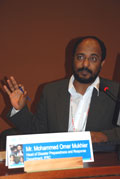

Young people are often seriously affected when disasters strike and can face severe difficulties in coping with unexpected and traumatic interruptions to their lives. But despite this, the world’s youth are also the very people who can teach their communities – and the wider world – how to reduce the risks and impact of disasters. Young people are unmatched by any other demographic group in their ability to bring about meaningful change in social behaviour and attitudes. We must not underestimate their potential to make a real difference in the time of disasters.
This is why children and young people are central to Red Cross Red Crescent disaster risk reduction efforts. Globally, around half of the 13 million Red Cross Red Crescent volunteers are young people. Not only do we pay special attention to their needs when disasters strike, but we also engage them in the design and implementation of disaster risk reduction programmes. We recognise their unique role and the value they can provide as innovators, inter-cultural ambassadors, peer-to-peer facilitators, community mobilizers, and advocates for vulnerable people.
In 2009, young people from 150 countries, representing the millions of young Red Cross Red Crescent volunteers, committed themselves to working on disaster preparedness, response and recovery, including innovative solutions in areas such as psychosocial support, advocacy for climate change adaptation, food security, and access to safe and clean water.
Since then, youth-led programming has proven to be effective even in the most challenging of environments, such as the Kwale communities in drought stricken Kenya. The award winning Kenya Red Cross Kwale communities project raised awareness amongst children and young people about the problems caused by climate change, provided them with necessary training, and mobilized them as agents of change in building the resilience of the communites to recurring drought and famine.
The young people involved in the project worked with Kwale communities to raise their awareness on causes and effects of climate change and ways in which they could adapt. With the help of the young Red Cross Red Crescent volunteers, communities improved their early warning and preparedness systems, updated the community disaster response plan and strengthened food security through promotion of modern farming methods. Through the project, the young volunteers also contributed to environmental conservation, improvement and better access to clean, safe and affordable water. For the Kwale communities, the result is that they have been able to withstand the Horn of Africa crisis better than many others. They also have the opportunity to teach others about the vital role young people can play in disaster risk reduction.
Tangible results have also emerged from Red Cross Red Crescent youth-led disaster risk reduction programmes in other countries including Bangladesh, Cook Islands, Costa Rica, El Salvador, Ethiopia, Fiji, India, Kenya, Niger, Panama, the Philippines, Senegal, South Africa, Thailand, Togo, and Uganda.
These are just some examples of what can be achieved when children and young people become aware of their responsibilities and potential to take an active part in the global efforts to resolve serious problems faced by humanity.
The International Federation of Red Cross Red Crescent Societies is calling on decision makers at all levels to recognize the vital role young people can and should play in reducing the risks associated with disasters. Specifically, we are calling on those who influence the funding, programme development and implementation of disaster risk reduction activities to recognize young people as powerful agents of change; encourage their unique abilities and skills such as intercultural communication and innovation in technology and thought; engage them in public awareness and education; involve them in decision making and planning at all levels; push hard for young people to have a stronger role in programme development and implementation in their own communities; and educate, elevate and empower young people by sharing responsibility and decision making in a genuine partnership.
These actions will undoubtedly help young people to do more, do better, and reach further in reducing disaster risks. Despite many challenges ahead of us, by working closely with children and young people, we can make communities all over the world safer and more resilient to disasters and their consequences. After all, the future is theirs.
Mohammed Omer Mukhier is Head of the Disaster Preparedness and Response Department at the International Federation of Red Cross and Red Crescent Societies.